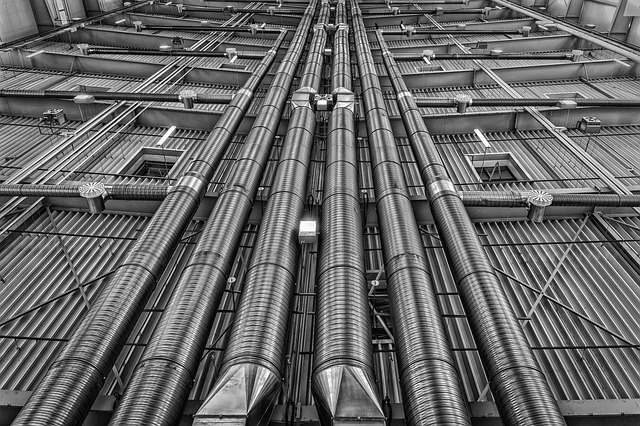Unit heaters, including gas-fired, electric, and suspended varieties, are efficient heating solutions for commercial and industrial spaces, supplementing forced air systems by targeting cold spots. Wall-sensor technology takes this efficiency a step further, allowing dynamic heating adjustments based on real-time occupancy and temperature data, resulting in significant energy savings over traditional heaters. Compact wall-sensor unit heaters, with their seamless wall mounting and targeted forced air heating, are especially valuable for industrial spaces, optimizing heat output while reducing waste and enhancing comfort. Regular maintenance ensures these intelligent heaters operate at peak efficiency, making them ideal for modern, sustainable commercial heating demands.
Compact wall-sensor unit heaters are transforming heating systems, promoting energy efficiency and cost savings. This article explores the growing importance of unit heaters as a key component in modern heating solutions, highlighting the innovative role of wall-sensor technology.
We’ll delve into how these compact units enhance energy conservation, offer tailored heating, and contribute to sustainable living. From understanding basic unit heaters to implementing advanced sensor technology, discover strategies for optimal performance and maintenance.
- Understanding Unit Heaters: A Key Component in Modern Heating Systems
- The Rise of Wall-Sensor Technology for Energy Efficient Heating
- How Compact Wall-Sensor Unit Heaters Enhance Energy Conservation
- Implementing and Optimizing: Strategies for Effective Use & Maintenance
Understanding Unit Heaters: A Key Component in Modern Heating Systems

Unit heaters are a vital component in modern heating systems, designed to efficiently warm specific areas within larger spaces such as warehouses, commercial buildings, and industrial sites. These versatile devices come in various types, including gas fired units, electric heaters, and suspended heaters, each offering distinct advantages tailored to different needs. Their primary role is to supplement forced air heating by targeting cold spots and ensuring uniform temperature distribution across vast and often irregular interiors.
The efficiency of unit heaters lies in their ability to control BTU capacity according to the area’s requirements, preventing energy wastage. Whether ceiling-mounted for optimal air circulation or strategically placed elsewhere, these compact devices are transforming industrial spaces by providing targeted, effective heating solutions without compromising on comfort or performance.
The Rise of Wall-Sensor Technology for Energy Efficient Heating

The integration of wall-sensor technology into heating systems represents a significant leap forward in energy efficiency and smart building design. These innovative sensors are transforming how we heat our spaces, particularly in commercial and industrial settings like warehouses. By focusing on the rise of this technology, builders and facility managers can now optimize their heating strategies, ensuring comfortable indoor environments while minimizing energy consumption.
Traditional heating systems, such as forced air heating or gas fired units, often rely on fixed or programmed schedules, leading to excessive heating in unoccupied areas. Wall-sensor unit heaters, however, offer a dynamic approach by measuring real-time occupancy and temperature data. This enables the system to adjust BTU capacity accordingly, activating only when needed and deactivating in vacant spaces, thus reducing energy waste commonly associated with conventional suspended heaters or ceiling mounted heating systems. This technology is especially beneficial for industrial spaces and commercial heating applications, where efficient energy utilization can lead to substantial cost savings.
How Compact Wall-Sensor Unit Heaters Enhance Energy Conservation

Compact wall-sensor unit heaters significantly enhance energy conservation in various settings, from warehouse applications to commercial and industrial spaces. These innovative heating solutions integrate advanced technology with sleek design, allowing them to be seamlessly mounted on walls, taking up minimal space. Unlike traditional suspended heaters or gas fired units that distribute heat indiscriminately, these sensors are designed to detect occupancy and adjust BTU capacity accordingly, providing only the necessary forced air heating. This targeted approach not only reduces energy waste but also creates a more comfortable environment by maintaining optimal temperatures in occupied areas.
Furthermore, their ceiling-mounted design makes them ideal for industrial spaces where high ceilings pose challenges for traditional heating systems. By optimizing heat output based on real-time occupancy data, these compact unit heaters ensure efficient use of resources, aligning with the growing demand for sustainable and cost-effective commercial heating solutions.
Implementing and Optimizing: Strategies for Effective Use & Maintenance

Implementing compact wall-sensor unit heaters in industrial spaces, warehouses, and commercial settings offers a strategic approach to energy efficiency. These suspended heaters, like gas fired units or electric heaters, are designed with advanced technology to respond to environmental conditions. By utilizing ceiling-mounted sensors, they automatically adjust heating output based on occupancy and temperature, ensuring optimal BTU capacity for forced air heating without unnecessary energy waste.
Regular maintenance is key to their effectiveness. Cleaning or replacing filters, as per manufacturer guidelines, ensures efficient air circulation. Additionally, periodic checks for any damage or debris buildup around the units’ vents promote even heat distribution. Given their intelligence and compact design, these wall-sensor heaters streamline commercial heating processes, making them ideal for various industrial spaces while contributing to energy conservation.
Compact wall-sensor unit heaters represent a significant advancement in energy-efficient heating technology. By leveraging innovative wall-sensor technology, these heaters offer precise temperature control and efficient energy distribution, ensuring comfort while minimizing energy consumption. Incorporating these units into modern heating systems allows for optimized energy conservation without compromising on indoor comfort, making them an essential component for sustainable living.
